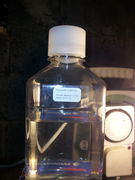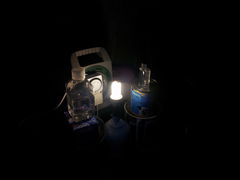Dinoflagellate: Difference between revisions
No edit summary |
|||
| Line 1: | Line 1: | ||
We are planning to maintain continuously cultures of bioluminescent algae for use in other projects. This requires timer controller lamps to train on light/dark cycles, and re-culturing periodically into new medium. | We are planning to maintain continuously cultures of bioluminescent algae for use in other projects. This requires timer controller lamps to train on light/dark cycles, and re-culturing periodically into new medium. | ||
Latest revision as of 20:21, 26 January 2015
We are planning to maintain continuously cultures of bioluminescent algae for use in other projects. This requires timer controller lamps to train on light/dark cycles, and re-culturing periodically into new medium.
Process:
- The algae are being trained in a light-dark cycle. The light dark cycle trains the algae to respond correctly.
- The algae are exposed to fluorescent light from 6AM GMT to 3PM GMT each day and covered in darkness from 3PM to 6AM during the night.
- Caps were loosened to allow for aeration.
Algae:
(source: microbewiki)
Pyrocysits fusiformis is a unicellular eukaryotic algae of the dinoflagellate phylum. This species is a marine plankton with the ability to produce bioluminescence in response to water movement and high shear flow, usually around ships, breaking waves, or movement of predators.
Cells are fusiform shaped, elongated with tapered ends, and have an average length and width of 970 x 163 µm with the equivalent spherical diameter being 374 cubic µm.
Bioluminescence of a blue color is produced instantaneously by this species when stimulated by movement, especially when cells are in high concentrations. Bioluminescence is dependent on circadian rhythm or the cycle of light and dark during a 24 hour period;
- agitation during the day produces little bioluminescence
- none is produced if cells are kept under constant lighted conditions.
Luminescence is most often produced by cells in the wake of ships, around swimming animals, or in breaking surface waves.
Bioluminescence is used by the organism as protection against predators by starling them with a flash of light or highlighting the movement of predators so that they are vulnerable to secondary predators. Both ways reduce the grazing pressure on P. fusiformis. On average P. fusiformis can produce 23-62 flashes per second lasting 210 milliseconds with a maximum photon intensity of 690 x 109 photons per second (these values are for the first flash). Bioluminescence is stimulated by shear flow, velocity gradient, or low pH.
Pyrocystis Classroom Culturing Kit was purchased from Empco.org. This kit includes a culture of bioluminescent dinoflagellates packaged in a Nalgene™ PET sterile bottle. The Pyrocystis Classroom Culturing Kit is ideal for classrooms and contains the materials necessary to grow algae for large classroom displays.
The sterile Nalgene™ Erlenmeyer flasks are ideal containers for growing Pyrocystis species because they include a 0.2 µm filter in the closure to permit sterile air exchange, supporting photosynthesis and respiration. The Erlenmeyer flasks also taper to maximize surface area of the liquid-air interface for improved gas exchange. The included L1 Algal Growth Medium acts to replenish nutrients and should be used to dilute overgrown cultures. Liquids included in this kit are non-toxic and safe for student use.
Recipes and Suppliers of media
L1 media
http://www.ccap.ac.uk/media/documents/L1_001.pdf
How to make artificial seawater
http://www.ccap.ac.uk/cultures/bioluminescentalgae.htm
list of algae media
CCAP have a big list of recipes in pdf form
http://www.ccap.ac.uk/media/pdfrecipes.htm
"National Center for Marine Algae and Microbiota" publish some recipes;
https://ncma.bigelow.org/algal-recipes
biocurious have published their "DIY dino growth media";
http://biocuriousmembers.pbworks.com/w/page/54282607/DIY%20dinoflagellate%20growth%20media
Source & References
Pyrocystis fusiformis
From MicrobeWiki, the student-edited microbiology resource
http://microbewiki.kenyon.edu/index.php/Pyrocystis_fusiformis
Other source
http://www.instructables.com/id/Grow-Your-Own-Bioluminescent-Algae/
Culture techniques and descriptions
Algal production

